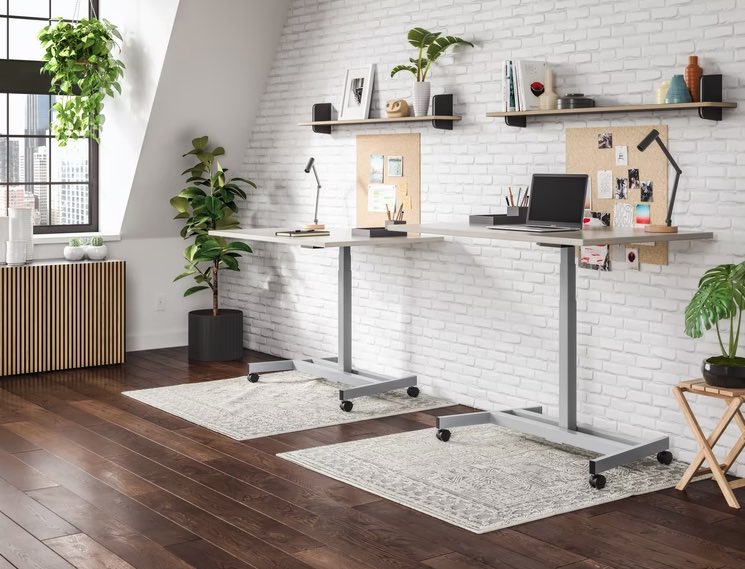We’ve all been slumped over a computer, typing away, back aching, shoulders hunched, as the hours tick away. Chances are, if you’ve ever been in this (poor) position, you’ve likely wondered about the benefits of standing at work.
Sitting too much is a common problem across Britain, with many of us partaking in the sedentary lifestyle with the aid of binge-watching TV, sitting in cars and at our computers. Couple this lifestyle with a Monday to Friday 9 to 5 job at a desk, and it’s a recipe for disaster.
Standing desks and treadmill desks have gained in popularity over the past several years. A recent survey of HR professionals reported that the use of standing desks had increased by 7% in the last year as an employer-provided office perk. Offering a standing desk is one of those easy wellness options for employers to support and improves office morale.
Studies have linked sitting a lot to these and other health problems. Even people who exercise most days face health risks if they sit too much. Standing desks raise your computer high enough for you to work and stand simultaneously. This keeps you on your feet for more of the day.
Sit stand desk benefits have been scientifically proven to improve your productivity and concentration and increase your creativity. This is because while you are standing, some of the body’s largest muscles are working, increasing blood flow to the brain. Therefore, it improves the way we feel and improves the way we work. It has also been found that sit-stand desks have the ability to increase productivity from up to 10-20%.
As well as becoming more productive, sit-stand desks will lead to much greater health than those who sit for an extensive period. It has been discovered that office workers spend 65% to 75% of their working hours sitting down. The majority of this takes place in prolonged periods of sustained sittings. A study published in the British Journal of Sports Medicine showed that compared with those who sit the least, those who sit the most are more than twice as likely to develop type 2 diabetes and cardiovascular disease and have a 13% and 17% increased risk of cancer incidence and mortality respectively.
As mentioned in the above paragraph, it requires the use of more muscles, so it’s no surprise that you burn more calories whilst using a sit-stand desk due to the increase in blood flow. Standing uses around 13 per cent more energy over the course of an eight-hour day, says Dr Dunstan, who is head of physical activity at Baker IDI Heart and Diabetes Institute. This accumulates to four hours standing, burning the equivalent to what you would if you went on a 45-minute walk.
Sit-stand desks don’t just have long term benefits, as they are also extremely beneficial in the short term for the body. Standing helps prevent a harmful build-up of sugars and fats in your blood. As a result, workers who stand more have better energy levels and concentration.
What Is a Standing Desk?
A standing desk, also called a stand-up desk, is basically a desk that allows you to stand up comfortably while working.
Many modern versions are adjustable so that you can change the height of the desk and alternate between sitting and standing.
These are referred to as height-adjustable desks or sit-stand desks.
Although research is still in its early stages, it does appear that using a standing desk can have impressive benefits for health. It may also increase productivity.
At the very least, using this type of desk can partly negate the harmful effects of sitting too much.
Types of Standing Desks
All standing desks follow the same basic idea — they let you work while you stand.
Fixed-height desks stay at your standing height. Sit-stand desks go up and down so you can sit or stand whenever you feel like it. Power sit-stand desks go up with the push of a button. You can lift manual ones with a handle or raise them with a lever or crank.
You can buy a standing desk online or at an office supply, electronics, or big-box store.
A basic fixed-height desk will cost you less than $100, but a really nice electric desk can cost more than $1,000. Treadmill desks take the idea a step further by letting you walk while you work, but they can cost more than $1,000. Why not try these out.

The Pros
Besides less sitting time, standing at work has other benefits:
More calories burned: One study showed that standing sheds 88 calories an hour, compared to 80 calories for sitting. Walking burns a lot more — 210 calories an hour.
Less back pain: Sitting for long periods of time tightens your muscles and can hurt your lower back, especially if you have bad posture. Standing desks seem to help ease back pain, but doctors don’t know how much time you need to stand to get this benefit.
More productive: In a study of call centre employees, those with standing desks were 45% more productive daily than employees who sat during their shift.
The Cons
Standing desks aren’t perfect. They can cause a few problems:
Leg and foot pain: Standing for long periods puts pressure on your knees, hips, and feet. This could lead to pain. Also, if you lift one foot to ease the pressure, being off-balance could affect your posture.
Vein problems: Being on your feet for too long makes blood collect in your leg veins. The vein may stretch to fit the extra blood and get weaker. This leads to varicose veins. People who stand for more than 6 hours a day are two or three times more likely to need surgery for varicose veins than people who stand or walk for less than 4 hours a day.
Standing doesn’t replace exercise: You’ll only burn a few more calories standing, which is better than nothing. But walking more than doubles your calorie burn. In addition, studies that compared the two showed treadmill desk users had much greater improvements in blood sugar and cholesterol levels than standing desk users.
Standing desks aren’t ideal for every task: You may be able to type or answer the phone while on your feet, but some tasks, like drawing and writing, are easier when you sit. See this here.
Frequently Asked Questions About Sit-Stand Desk
Are sit/stand desks beneficial?
Advocates of standing desks point to studies showing that after a meal, blood sugar levels return to normal faster on days a person spends more time standing. And standing, rather than sitting, may reduce the risk of shoulder and back pain.
How long should you stand at a standing desk?
Sitting behind your desk all day is bad for your health, and experts have long been advising people to stand at their workstations for about 15 minutes an hour. But a University of Waterloo professor says his research shows that people should be standing for at least 30 minutes per hour to get health benefits.
Are standing desks better for posture?
Those who used standing desks during the studies reported an improvement of up to 32% in their lower back and neck pain after using the desk for a period of several weeks.
Do you lose weight with a standing desk?
Standing desks won’t make you lose weight, and they also don’t make you significantly healthier or more productive, according to a new analysis of 53 sit-stand desk studies.
Do standing desks improve productivity?
The popular desks also improved their productivity – significantly. The study, which monitored 167 employees in a Texan call centre over six months, found that stand-capable desks employees were more productive than their colleagues in standard, seated desks.

Benefits Of Sit-Stand Desks
Now that you have an overview of the science behind the concept, we’re going to identify and explain the benefits of sit-stand desks.
Allows you to break up hours of sitting
As we’ve explained in the previous section, sitting down for too long is harmful. However, it’s also inevitable if you work in an office.
The idea of getting up for breaks every hour may sound doable in principle, but in practice, it may be less so. For example, you may be working to tight deadlines and not have the time to spare; you might work in customer service and have to be present to answer the phones.
The first benefit of sit-stand desks is the ability to break that streak of sitting down while still working. You can seamlessly switch between sitting and standing during the workday, so you don’t have to take constant breaks.
Standing is beneficial for your health (in moderation)
Standing ensures you aren’t sitting still for too long, but standing for part of the day is actively good for your health. For example, standing for three hours a day has the health benefits of running 10 marathons a year!
You have the option to sit and stand.
We’ve touched on the fact that standing all day can be just as harmful as sitting, so having a standing desk may not be the solution. However, one of the biggest health benefits of sit-stand desks is the ability to adjust the settings to both sitting and standing heights. This allows you and your employees to create a balance between the two throughout the day that fits you.
Good for productivity and focus
There are workplace improvements among all the health benefits of sit-stand desks. For example, studies have shown that the introduction of sit-stand desks in some offices increased productivity by 46%! So not only do sit-stand desks improve your employee’s health, but they also improve their working ability – a solid investment in our books.
Remember to Take Breaks
Even though standing at your desk is better than sitting, you should still take regular breaks to move and stretch, clear your head and rest your eyes. Learn this here now.
Those quick breaks come naturally for some people, while others may need an automated reminder.
A great option is installing reminder software on your computer or downloading a break reminder app on your phone. There are many free versions of both of these.
One study found that call centre employees experienced less upper limb and back discomfort.
It is recommended that when working at your desk, you should spend at least a minimum of two hours on your feet, this with the main aim of reaching an ideal four hours. Seated work needs to be regularly broken up with standing work. As well as avoiding too much-seated work, remaining in a static standing posture should also be avoided. This is why it’s advised to regularly charge or shift weight between your legs to reduce leg fatigue. As well as shifting weight, you should also frequently adjust the posture of your body throughout the working day. Occupational standing has not been shown to cause any damage to your lower back or your neck; if anything standing helps to provide relief to the muscles.
People who are new to standing based work may experience some musculoskeletal sensations and fatigue, as the body still needs to adapt to its new way of working. If these pains don’t decrease after changing posture or going on a walk, then it’s suggested for the worker to have a rest. This is in a position that helps to relieve all sensations. If there are still issues after this, medical advice should be sought. Employees must promote to their staff that prolonged time sitting can dramatically increase someone’s risk of cardiometabolic diseases and premature death.

